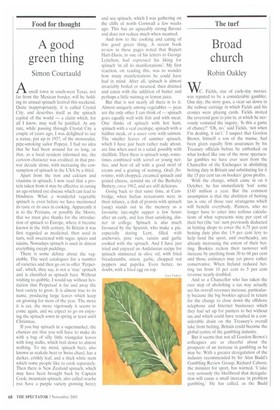Food for thought
A good green thing
Simon Courtauld
Asmall town in south-west Texas, not far from the Mexican border, will be holding its annual spinach festival this weekend. Quite inappropriately, it is called Crystal City, and describes itself as the spinach capital of the world — a claim which, for all I know, may well be justified. At any rate, while passing through Crystal City a couple of years ago, I was delighted to see a statue, put up in 1937, of the monocular, pipe-smoking sailor Popeye. I had no idea that he had been around for so long, or that, as a local resident informed me. the cartoon character was credited, in that prewar decade alone, with increasing the consumption of spinach in the USA by a third.
Apart from the iron and calcium and vitamins in spinach, I now read that a protein taken from it may be effective in curing an age-related eye disease which can lead to blindness. What a wonderful vegetable spinach is, even before we have mentioned its taste or its uses in cooking. Apparently it is to the Persians, or possibly the Moors, that we must give thanks for the introduction of spinach to Europe, where it became known in the 16th century. In Britain it was first regarded as medicinal, then used in tarts, well sweetened with sugar, spices and raisins. Nowadays spinach is used in almost everything except puddings.
There is some debate about the vegetable. The seed catalogues list a number of varieties and then go on to offer 'Perpetual', which, they say, is not a 'true' spinach and is classified as spinach beet. Without wishing to quibble. I would say without hesitation that Perpetual is far and away the best variety to grow. It is almost true to its name, producing large leaves which keep on growing for most of the year. The more it is cut, the more vigorously it seems to come again, and we expect to go on enjoying the spinach sown in spring at least until Christmas.
If you buy spinach in a supermarket, the chances are that you will have to make do with a bag of silly little triangular leaves with long stalks, which boil down to almost nothing. To my mind, spinach beet, also known as seakale beet or Swiss chard, has a darker, crinkly leaf, and a thick white stem which some people like to cook separately. Then there is New Zealand spinach, which may have been brought back by Captain Cook; mountain spinach, also called orache (we have a purple variety growing here); and sea spinach, which I was gathering on the cliffs of north Cornwall a few weeks ago. This has an agreeably strong flavour and does not reduce much when steamed.
And now to the cooking and eating of this good green thing. A recent book review in these pages noted that Rupert Hart-Davis, in one of his letters to George Lyttelton, had expressed his liking for spinach 'in all its manifestations'. My first reaction, on reading this, was to wonder how many manifestations he could have had in mind. After all, spinach is almost invariably boiled or steamed, then drained and eaten with the addition of butter and perhaps a little nutmeg or lemon juice.
But that is not nearly all there is to it. Almost uniquely among vegetables — peas are the only other I can think of — spinach goes equally well with fish and with meat. One thinks of spinach with hot ham, spinach with a veal escalope, spinach with a halibut steak, or a sauce verie with salmon. The smaller leaves of summer spinach, which I have just been rather rude about, are fine when used in a salad, possibly with shellfish. Then there is spinach soup, sometimes combined with sorrel or young nettles, and best of all with a good swirl of cream and a grating of nutmeg. atifs florentine, with chopped, creamed spinach and grated cheese, remind me of the Berkeley Buttery, circa 1962, and are still delicious.
Going back to that same time, at Cambridge, when Indian restaurants were in their infancy, a dish of prawns with spinach (saag) stands out in the memory as a favourite late-night supper a few hours after an early, and less than satisfying, dinner in college. Spinach is also much favoured by the Spanish, who make a pie, especially during Lent, filled with anchovies, pine nuts, raisins and garlic cooked with the spinach. And I have just tried and enjoyed an Andalusian recipe for spinach simmered in olive oil, with fried breadcrumbs, onion, garlic, chopped red peppers and paprika. Even better, no doubt, with a fried egg on top.
Lucy Vicken


















































































 Previous page
Previous page